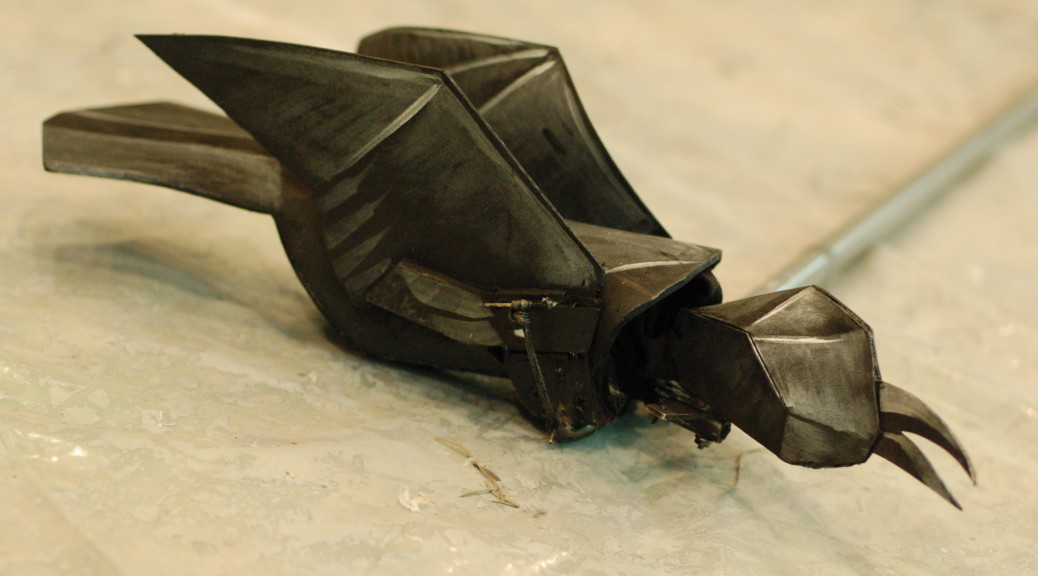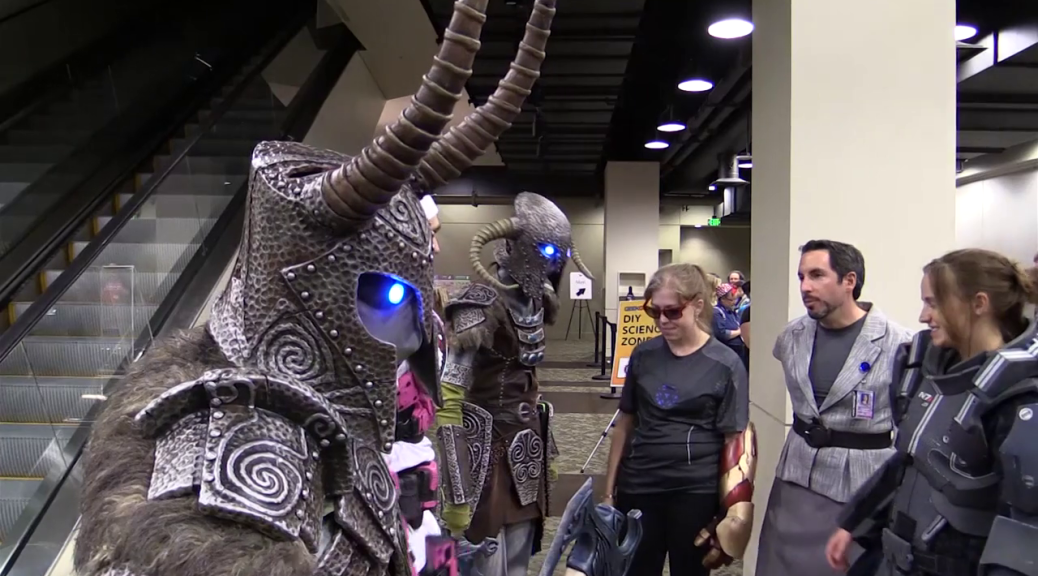If you have an hour to spare, this PBS special from 1981 is all about the making of Raiders of the Lost Ark. It’s quite in-depth and full of a lot of the practical and technical aspects of creating a film as ambitious as this one was. While this documentary does not touch on props much, it is fascinating to see all the practical challenges which needed to be solved in the days before computer graphics took over everything.
The 100 Best Sites for the Prop Maker
When I began my blog back in 2009, it felt like only a handful of sites for the prop maker were out there. Since then, the field has practically exploded and you can find information everywhere. I post links to sites regularly, but I wanted to make a list of the sites you should be checking out regularly. So I’ve collected and categorized what I consider to be the 100 best sites for a prop maker. Now, this is far from comprehensive, particularly if you are working on specific objects or using less-popular materials, but hopefully it will keep you busy for awhile. If you know of a site I’ve missed, drop a note in the comments or send me an email!
Forums
Forums remain a great way to find information about prop making, since much of what we do is so specific and unique. You can ask a question, search for answers to other questions, or just browse through and pick up tips on how other people work.
- Replica Prop Forum – A very active and very informative forum filled with fans recreating their favorite props from films, television, video games and other media.
- ControlBooth – A US forum for technical theatre, with a small section on props.
- Blue Room Technical Forum – A UK forum for technical theatre, also with a section on props.
- The 405th – Halo costuming forum
- Dented Helmet – Boba Fett costume resource
- The Hunter’s Lair – Predator Costume and Prop forum
- Astromech – Forum for the R2-D2 Builders Club
- Cosplay – For fans of dressing up as fictional characters, this also has sections on props and similar items.
- PropPeople Forum – A once-thriving forum that still limps on, this is the only one devoted entirely to props people working in theatre.
- TheatreFace – Forums built around the TheatreFace social network, with a section on props.
- Brass Goggles – Steampunk forum with some prop-making threads
- The FX Lab – Special makeup effects, mask making and creature design.
- Haunt Forum – Lots of information for those who build their own sets and props for Halloween displays and haunted houses.
- The Clubhouse – For modelers, sculptors and model collectors.
- Concept Art – Forum for concept artists with a small section for sculpture and other 3D media.
Prop Makers
Many prop makers have their own website or post their work online, but a few go the extra mile and show how they’ve built specific props.
- Volpin Props – Unique commissions for props and objects based off of items from video games, television and films.
- Punished Props – Another fine replica artist making props from video games and other pop culture.
- Fake ‘n Bake – If you ever want to make fake food, Anna Warren’s site should be your first stop.
- Dave Lowe Design – One of the prop masters at the Hallmark Channel.
- Kamui Cosplay – Armor and cosplay from Wonderflex and Worbla built by this talented German artist.
- Blind Squirrel Props – A replica prop maker working on commissions and personal projects from all manner of films, television shows and video games.
- Folkenstal – Interesting weapons and items based on the video game Skyrim.
- Theatre Projects – Props and prop-related information from a freelance theatre prop master in Chicago.
- Amethyst Angel – Armor and other cosplay projects.
- Jay Surma – Another prolific replica prop maker.
- 2StoryProps – Yet another replica prop maker.
- MRX Designs – A prop maker working in the Steampunk and Lovecraft genres.
- Tom Banwell – Leather and resin Steampunk projects.
- Barnyard FX – A behind-the-scenes look at the props, exhibits and displays by Greg Aronowitz, a prolific special effects artist and design specialist on over two hundred films and television projects.
- Spirits Dancing – Puppetry and prop-making from Hilary Talbot, a working Australian artisan.
- Fevereon Props – A prop and costume maker out of Georgia.
Blogs
A number of sites may not be devoted entirely to teaching prop-making, but they still have regular tutorials, news and information relevant to the prop maker, or deal with comparable and related industries.
- Prop Agenda – Now, I couldn’t omit my own blog. How-tos, news, videos and more from the props world.
- Make Magazine – Blog companion to the magazine, this site regularly has posts on prop making and associated materials.
- Tested – What began as site for testing consumer electronics has quickly grown to have regular features on props and prop making, particularly with Adam Savage as one of the regular hosts.
- Propnomicon – A regularly-updated look at props built around the mythos of HP Lovecraft.
- Lost in Schlock – Down and dirty prop making tips for low-budget films.
- Design Realisation – backstage at the Guildhall School of Music & Drama.
- La Bricoleuse – costume crafts teacher at University of North Carolina Chapel Hill.
- StageBitz – a prop inventory software company that regularly posts prop-related news and interviews.
- David Neat – Theatrical model making.
- Stan Winston School – The new school run by the peerless studio responsible for the most famous practical film effects of the last thirty years runs a blog of related information. The school also has online video classes you can take for a paid subscription.
- Meanwhile in the prop shop…Â – A Tumblr of random encounters in a regular props shop.
- Theatre Safety – Articles and information on safety in the performing arts.
- Technical Direction Tidbits – News and tidbits from the world of technical theatre.
- Rosco – Spectrum – while also a lighting company, they do have tutorials on their paint and coating products
- Mantle Studios – The sculpting blog of Jason Babler
- The Dark Power – Bizarre sculptures and metal art with a theatrical flair.
- Design*Sponge – Inspiration and reference for all manner of interior-design and furniture-related things.
- Fake Believe – A behind-the-scenes look at props and sets made for various photography projects.
- Haunters Digest – Tutorials and showcases of haunted house props and Halloween decorations.
Tutorials
If you need to learn how to build specific items or work with certain materials, these sites have collected the information you need.
- Instructables – If you need to build something, chances are, you can find a tutorial here from someone who has already built it. This site should be your first stop for finding how-to’s, period.
- Smooth-On videos – Tons of videos on molding and casting.
- Deviant Art – You have to do some digging, but people post a lot of tutorials here, or post props with a detailed “how-to” in their description.
- Woodgears.ca – Wood working by an engineer.
- Hirst Arts Fantasy Architecture – Tutorials for molding, casting and painting of miniatures and models.
- Ultimate Paper Mache – Information and tutorials on, you guessed it, paper mache.
- Monster Makers – You may never need to make monsters, but you may find their tutorials on sculpting, molding and casting, working with foam latex and painting to be helpful.
- Paint-Sculpt – Tutorials and reference for both painting, and, wait for it, sculpting.
- The Gizmologist’s Lair – A cornucopia of tutorials and links to all manner of gizmo-related projects.
- Craftster – Projects and tutorials from the crafty side of the prop-making spectrum.
- Mask Makers Web – Information and links for things related to masks and mask-making.
- Costume Properties Construction Handbook – An online book of sorts with helpful information on building objects like hats, armor and masks.
- Puppetry Home Page – Information on building puppets, and lots of links to other sites.
- Proptology – A magazine devoted to props from 1995-2004 with some articles available online
Tools and Reference
- Fastener Information – Everything you want to know about bolts, screws and similar fasteners.
- This to That – Interactive tool for selecting adhesives for specific materials.
- Golden Paints virtual paint mixer – Pick a color and this site will tell you which acrylic paint colors to mix to get that color.
- Glass Attic – 1700 pages of everything you need to know about polymer clay.
- Green Theater Choices Toolkit – A rundown of common building and crafting materials ranked by their environmental impact.
- Sizes – A vast index with information about the sizes of practically everything. From definitions of units of measurements, to standard sizes of common furniture, to sheet metal gauges, and everything in between.
- Pocket Guide to Chemical Hazards – A guide to help workers recognize and control common chemical hazards in the workplace.
- Wood Database – Pictures and information for identifying or selecting hundreds of types of wood species.
- Toxipedia – Encyclopedia of toxins.
- Arts, Crafts & Theater Safety – Provides health and safety information to artists worldwide.
- Beacon Adhesives Adhesive Selection Chart – Like “This to That”, but dedicated to adhesives from the Beacon company.
- Colorit Color Formula Guide – Pick a color to see which RIT dyes to mix to get that color.
- Chemistry in the Toy Store – A look at the chemistry of various toys, including recipes to make your own slime, play dough, disappearing ink and other novelties.
- Properties Directors Handbook – An online book showing how a theatrical props shop is setup and organized.
Research
- Internet Movie Firearms Database – A comprehensive look at every firearm from every film, whether it was a real gun or adapted into a more fictional weapon.
- Production Illustration and Concept Design – Artwork from the planning and pre-production phase of dozens of films.
- Woodworkers Library – Over 200 out-of-print woodworking books you can read online for free.
- Collectors Weekly – One of the best sites devoted to delving into the history of specific objects and antiques.
- Retronaut – Lots of pictures and illustrations from throughout history, organized by theme or event.
- Accidental Mysteries – Strange, bizarre and magical art and objects from today and the past.
- Smithsonian Institute 3D models – Scanned three-dimensional computer files of some of the objects from the Smithsonian’s vast collection.
- Library of Congress Digital Collections – Digitized versions of the LOC’s many holdings, including one of the largest historical newspaper archives around.
- New York Public Libary Digital Collections – Tons of digitized content from the NYPL’s collections, including their vast theatre and performing arts collection.
- American Museum of Natural History photo collection -Â A look at various items in their collection, as well as some behind-the-scenes photographs taken during the construction of their famed dioramas.
- Science Museum History of Medicine objects – Thousands of objects used by doctors and other practitioners throughout history.
- The History and Geography of Inventions – Find out where and when many common items first appeared.
- Click Americana – Memories and memorabilia from US history.
- National Park Service Museum Collections – Lots of items and objects from their various museums and parks around the US.
- American Package Museum – Hundreds of images of vintage and antique cans, bottles, boxes and other packages from the US.
Organizations and job sites
Finally, if you want to join a larger community of props people or find a job in the industry, check these sites out.
- S*P*A*MÂ – The Society for Props Artisan Managers is an organization of North American prop directors.
- USITT – The United States Institute for Theatre Technology.
- Association of British Theatre Technicians
- ArtSearch – A paid subscription site with job postings for US theatre and educational theatre.
- Backstage Jobs – A free site for job postings around the US.
- Stage Jobs Pro (UK) and Stage Jobs Pro (US)
- Set Decorators Society of America – An organization of Hollywood set decorators with some in-depth looks at the work of their members.
Crow Puppet
My major project for the past few months involved engineering and constructing a number of animal puppets for Triad Stage’s production of “Snow Queen”. I wrote about the white-tailed stag last week. One of the most complicated puppets in terms of motion and movement was the crow. He also had the most stage time out of all the puppets, appearing on his own in several scenes. I began work on him shortly after beginning the stag, so that I could have plenty of time to develop the means to have a single puppeteer perform all the actions he needed to perform.
You can see a bit of the “evolution” of the puppet’s mechanisms in this video.
The major difference between the prototype puppet in the video and the final puppet was that I switched the pole to connect on the side rather than from behind. It gave the puppeteer much more control over the puppet by letting him manipulate the orientation of the crow’s body by twisting the main control pole, rather than having to stoop and squat.
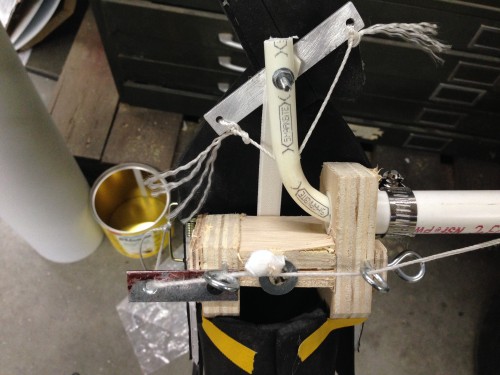
As you saw in the video, the head and neck were controlled by an inner pole which was free to rotate on its own. Strings ran inside which could turn a bar that held the head.
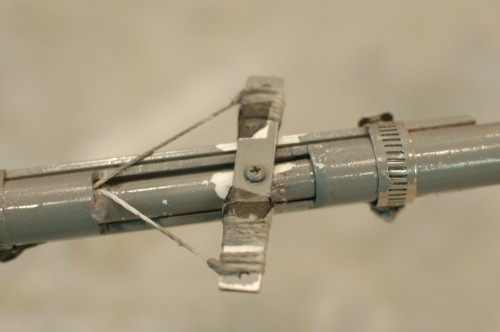
At the other end of the control bar was a similar bar that held the other ends of these strings. The puppeteer could both swing the bar back and forth and rotate the inner pole with just one hand. The other hand was free to flap the wings.
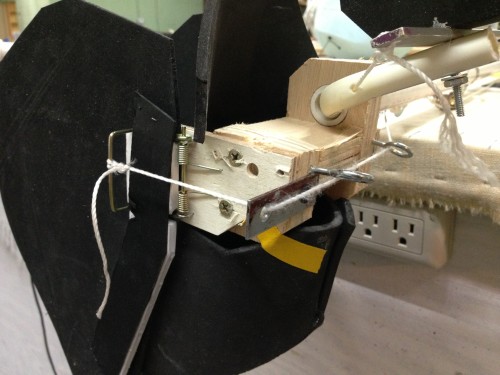
If you look closely, you will see the wings were actually attached to mousetraps. Pulling a string moved the wings down, and the springs in the mousetrap moved the wings back up when the string was released.
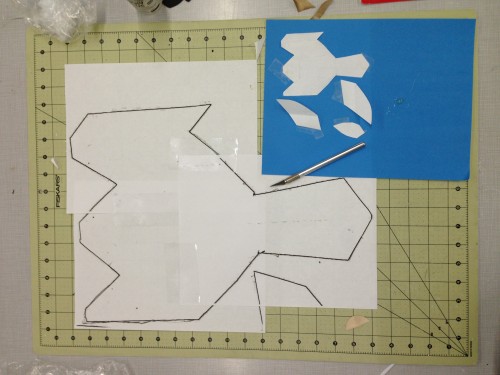
The pattern for the crow’s body was developed in a small prototype by the puppet designer, Bill Brewer. I enlarged this pattern and cut it out of black EVA foam sheets. I came up with a pattern for the head and beak to match the look; like the other puppets in the show, the appearance was not meant to be realistic, but was stylized to make the crow look like he was cut and folded out of sheets of paper.
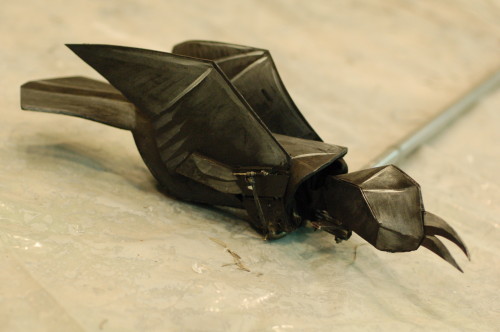
The solid black crow tended to disappear when on stage, so he was given a final paint job by the scene designer, Howard Jones. He accentuated the flat planes and folds on the crow with white and silver paint, helping make the crow “pop” against the background.
Friday Fun Time Link-o-Rama
Chrix Designs shows how she made a staff of Kraken; it’s a staff with an orb surrounded by octopus tentacles. I found her technique for making the sculpted tentacles pretty interesting.
Kris Compas shows how to turn on a drill press in this two-part tutorial (see part 1 and part 2). Now, a drill press motor isn’t made to withstand the lateral pressure from full-scale turning of hardwoods , but Compas is turning doll-house furniture pieces out of basswood. This seems like a fine technique for all that small-scale kind of stuff you might need to do.
For Nic Howard, nothing is safe when it comes to molding and casting. She shows how she molds everything from bookplates to cookies in order to have a library of decorative castings to attach to objects.
Cosplay Boom interviews Bill Doran of Punished Props in this video. Doran talks about how he got started and what he loves about making props.
Finally, American Horror Story’s two assistant props masters take you behind-the-scenes for a look at some of their props in this video:
Shenanigans in Poughkeepsie, 1871
The following is taken from an article which first appeared in The Daily Evening Telegraph in 1871:
The Property Man is one of the first grand essentials of the theatre. The success of every piece, no matter how slight, depends in a great measure on him. Everything on the stage, except the scenery, are properties. The word is oftenest applied to small articles used by the performers, but these are a part only of the great mass of such material. Furniture of every sort are properties. These large pieces are termed “stage props” in opposition to “hand props.” The best “stage props”—parlor sets, etc.—are sometimes very handsome and are used very carefully. In modern society pieces it is quite the custom now to hire furniture of a dealer for the run of the piece. Property men in the country (as theatrical stands outside of the larger towns are termed) are often sorely perplexed in this respect. They have in such cases nearly always to hire, and it often happens that furniture men are a narrow-minded set of heathens, for whom the drama has no æsthetic attractions whatever. The strangest things have been done under these circumstances. The curtain must go up—so much is sure; and that great results can be accomplished under the stress of a “must” more important affairs than things theatrical have proved.
We heard of a sharp fellow once who, being with a travelling company, struck a town whose shopkeepers were all of the very strictest sort. He had to have a sofa and some other furniture for a piece to be played, and he could neither hire, borrow, buy, nor steal it. They would rather chop it up, the owners said, than have it go inside of a theatre. Our man, not discouraged however, set his wits to work. He got another person to purchase the required goods, and to have them sent with the bill to a hotel, where they should be paid for on delivery. The car driver was in the trick, and the furniture was swiftly driven to the theatre. It was only required in the first piece, and by 9 o’clock it was back in the owner’s store (not a whit worse than an hour and a half before, except that a few profane stage-players had touched it), with the message that it did not exactly suit the intended purchaser. This clever trick was played in Poughkeepsie, and the daring wretch who devised it yet lives to boast of his exploit.
Originally published in The Daily Evening Telegraph, Philadelphia, May 12, 1871, pg 5.


